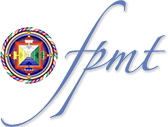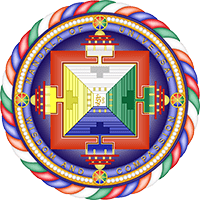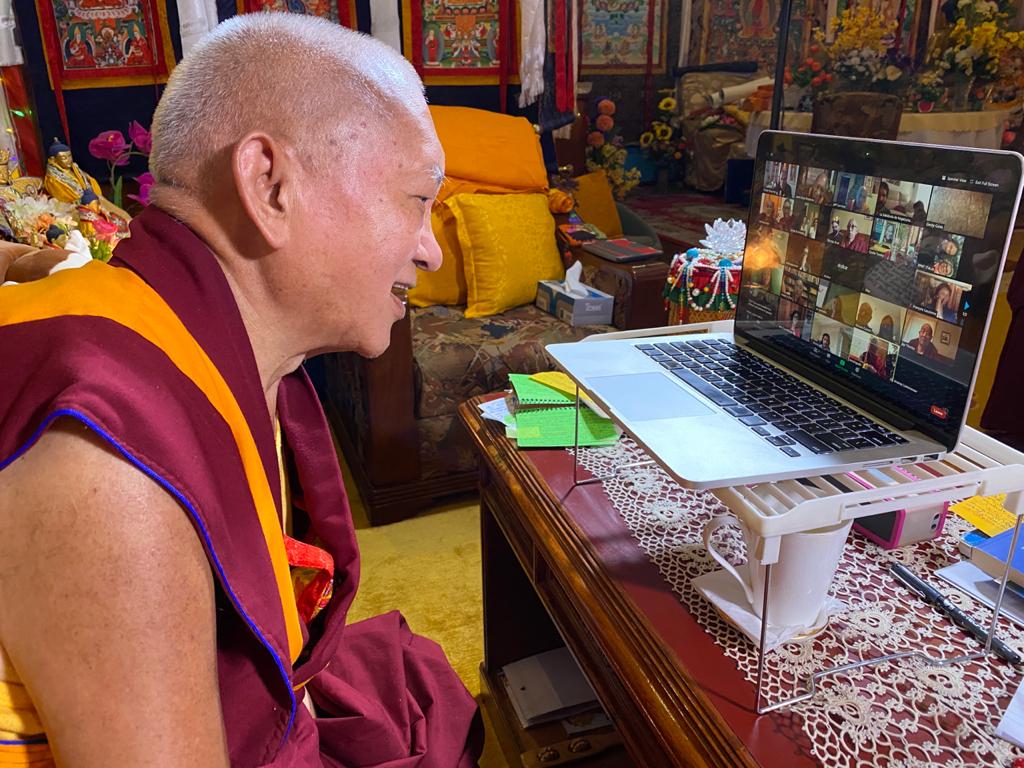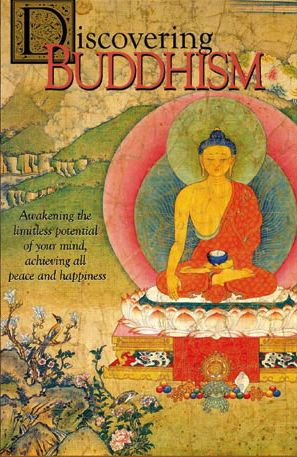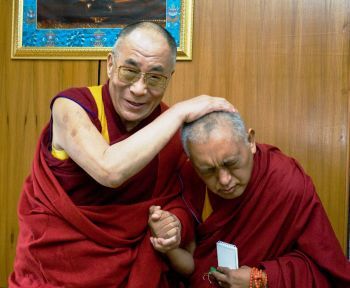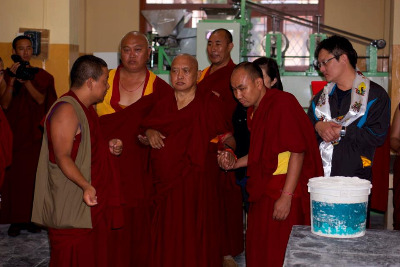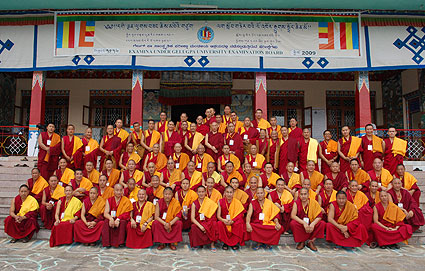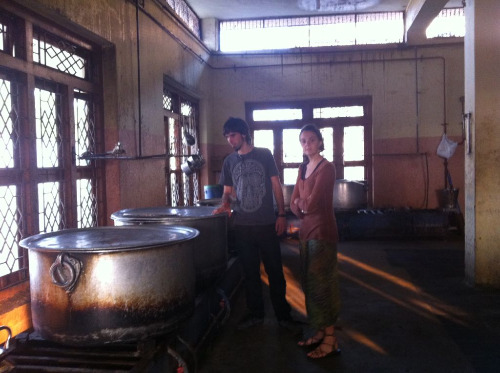- Home
- FPMT Homepage
Foundation for the Preservation of the Mahayana Tradition
The FPMT is an organization devoted to preserving and spreading Mahayana Buddhism worldwide by creating opportunities to listen, reflect, meditate, practice and actualize the unmistaken teachings of the Buddha and based on that experience spreading the Dharma to sentient beings. We provide integrated education through which people’s minds and hearts can be transformed into their highest potential for the benefit of others, inspired by an attitude of universal responsibility and service. We are committed to creating harmonious environments and helping all beings develop their full potential of infinite wisdom and compassion. Our organization is based on the Buddhist tradition of Lama Tsongkhapa of Tibet as taught to us by our founders Lama Thubten Yeshe and Lama Thubten Zopa Rinpoche.
- Willkommen
Die Stiftung zur Erhaltung der Mahayana Tradition (FPMT) ist eine Organisation, die sich weltweit für die Erhaltung und Verbreitung des Mahayana-Buddhismus einsetzt, indem sie Möglichkeiten schafft, den makellosen Lehren des Buddha zuzuhören, über sie zur reflektieren und zu meditieren und auf der Grundlage dieser Erfahrung das Dharma unter den Lebewesen zu verbreiten.
Wir bieten integrierte Schulungswege an, durch denen der Geist und das Herz der Menschen in ihr höchstes Potential verwandelt werden zum Wohl der anderen – inspiriert durch eine Haltung der universellen Verantwortung und dem Wunsch zu dienen. Wir haben uns verpflichtet, harmonische Umgebungen zu schaffen und allen Wesen zu helfen, ihr volles Potenzial unendlicher Weisheit und grenzenlosen Mitgefühls zu verwirklichen.
Unsere Organisation basiert auf der buddhistischen Tradition von Lama Tsongkhapa von Tibet, so wie sie uns von unseren Gründern Lama Thubten Yeshe und Lama Thubten Zopa Rinpoche gelehrt wird.
- Bienvenidos
La Fundación para la preservación de la tradición Mahayana (FPMT) es una organización que se dedica a preservar y difundir el budismo Mahayana en todo el mundo, creando oportunidades para escuchar, reflexionar, meditar, practicar y actualizar las enseñanzas inconfundibles de Buda y en base a esa experiencia difundir el Dharma a los seres.
Proporcionamos una educación integrada a través de la cual las mentes y los corazones de las personas se pueden transformar en su mayor potencial para el beneficio de los demás, inspirados por una actitud de responsabilidad y servicio universales. Estamos comprometidos a crear ambientes armoniosos y ayudar a todos los seres a desarrollar todo su potencial de infinita sabiduría y compasión.
Nuestra organización se basa en la tradición budista de Lama Tsongkhapa del Tíbet como nos lo enseñaron nuestros fundadores Lama Thubten Yeshe y Lama Zopa Rinpoche.
A continuación puede ver una lista de los centros y sus páginas web en su lengua preferida.
- Bienvenue
L’organisation de la FPMT a pour vocation la préservation et la diffusion du bouddhisme du mahayana dans le monde entier. Elle offre l’opportunité d’écouter, de réfléchir, de méditer, de pratiquer et de réaliser les enseignements excellents du Bouddha, pour ensuite transmettre le Dharma à tous les êtres. Nous proposons une formation intégrée grâce à laquelle le cœur et l’esprit de chacun peuvent accomplir leur potentiel le plus élevé pour le bien d’autrui, inspirés par le sens du service et une responsabilité universelle. Nous nous engageons à créer un environnement harmonieux et à aider tous les êtres à épanouir leur potentiel illimité de compassion et de sagesse. Notre organisation s’appuie sur la tradition guéloukpa de Lama Tsongkhapa du Tibet, telle qu’elle a été enseignée par nos fondateurs Lama Thoubtèn Yéshé et Lama Zopa Rinpoché.
Visitez le site de notre Editions Mahayana pour les traductions, conseils et nouvelles du Bureau international en français.
Voici une liste de centres et de leurs sites dans votre langue préférée
- Benvenuto
L’FPMT è un organizzazione il cui scopo è preservare e diffondere il Buddhismo Mahayana nel mondo, creando occasioni di ascolto, riflessione, meditazione e pratica dei perfetti insegnamenti del Buddha, al fine di attualizzare e diffondere il Dharma fra tutti gli esseri senzienti.
Offriamo un’educazione integrata, che può trasformare la mente e i cuori delle persone nel loro massimo potenziale, per il beneficio di tutti gli esseri, ispirati da un’attitudine di responsabilità universale e di servizio.
Il nostro obiettivo è quello di creare contesti armoniosi e aiutare tutti gli esseri a sviluppare in modo completo le proprie potenzialità di infinita saggezza e compassione.
La nostra organizzazione si basa sulla tradizione buddhista di Lama Tsongkhapa del Tibet, così come ci è stata insegnata dai nostri fondatori Lama Thubten Yeshe e Lama Zopa Rinpoche.
Di seguito potete trovare un elenco dei centri e dei loro siti nella lingua da voi prescelta.
- 欢迎 / 歡迎
简体中文
“护持大乘法脉基金会”( 英文简称:FPMT。全名:Foundation for the Preservation of the Mahayana Tradition) 是一个致力于护持和弘扬大乘佛法的国际佛教组织。我们提供听闻,思维,禅修,修行和实证佛陀无误教法的机会,以便让一切众生都能够享受佛法的指引和滋润。
我们全力创造和谐融洽的环境, 为人们提供解行并重的完整佛法教育,以便启发内在的环宇悲心及责任心,并开发内心所蕴藏的巨大潜能 — 无限的智慧与悲心 — 以便利益和服务一切有情。
FPMT的创办人是图腾耶喜喇嘛和喇嘛梭巴仁波切。我们所修习的是由两位上师所教导的,西藏喀巴大师的佛法传承。
繁體中文
護持大乘法脈基金會”( 英文簡稱:FPMT。全名:Found
ation for the Preservation of the Mahayana Tradition ) 是一個致力於護持和弘揚大乘佛法的國際佛教組織。我們提供聽聞, 思維,禪修,修行和實證佛陀無誤教法的機會,以便讓一切眾生都能 夠享受佛法的指引和滋潤。 我們全力創造和諧融洽的環境,
為人們提供解行並重的完整佛法教育,以便啟發內在的環宇悲心及責 任心,並開發內心所蘊藏的巨大潛能 — 無限的智慧與悲心 – – 以便利益和服務一切有情。 FPMT的創辦人是圖騰耶喜喇嘛和喇嘛梭巴仁波切。
我們所修習的是由兩位上師所教導的,西藏喀巴大師的佛法傳承。 察看道场信息:
- FPMT Homepage
- News/Media
-
- Study & Practice
-
-
- About FPMT Education Services
- Latest News
- Programs
- New to Buddhism?
- Buddhist Mind Science: Activating Your Potential
- Heart Advice for Death and Dying
- Discovering Buddhism
- Living in the Path
- Exploring Buddhism
- FPMT Basic Program
- FPMT Masters Program
- FPMT In-Depth Meditation Training
- Maitripa College
- Lotsawa Rinchen Zangpo Translator Program
- Universal Education for Compassion & Wisdom
- Online Learning Center
-
- Prayers & Practice Materials
- Overview of Prayers & Practices
- Full Catalogue of Prayers & Practice Materials
- Explore Popular Topics
- Benefiting Animals
- Chenrezig Resources
- Death & Dying Resources
- Lama Chopa (Guru Puja)
- Lama Zopa Rinpoche: Compendium of Precious Instructions
- Lama Zopa Rinpoche: Life Practice Advice
- Lama Zopa Rinpoche Practice Series
- Lamrim Resources
- Mantras
- Prayer Book Updates
- Purification Practices
- Sutras
- Thought Transformation (Lojong)
- Audio Materials
- Dharma Dates - Tibetan Calendar
- Translation Services
- Publishing Services
- Ways to Offer Support
- Prayers & Practice Materials
-
- Teachings and Advice
- Find Teachings and Advice
- Lama Zopa Rinpoche Advice Page
- Lama Zopa Rinpoche: Compendium of Precious Instructions
- Lama Zopa Rinpoche Video Teachings
- ༧སྐྱབས་རྗེ་བཟོད་པ་རིན་པོ་ཆེ་མཆོག་ནས་སྩལ་བའི་བཀའ་སློབ་བརྙན་འཕྲིན།
- Podcasts
- Lama Yeshe Wisdom Archive
- Buddhism FAQ
- Dharma for Young People
- Resources on Holy Objects
- Teachings and Advice
-
-
*If a menu item has a submenu clicking once will expand the menu clicking twice will open the page.
-
-
- Centers
-
- Teachers
-
- Projects
-
-
-
-
*If a menu item has a submenu clicking once will expand the menu clicking twice will open the page.
-
-
- FPMT
-
-
-
-
-
There is no samsaric pleasure that is new, so let go of the clinging that creates samsara.
Lama Zopa Rinpoche
-
-
-
- Shop
-
-
-
The Foundation Store is FPMT’s online shop and features a vast selection of Buddhist study and practice materials written or recommended by our lineage gurus. These items include homestudy programs, prayers and practices in PDF or eBook format, materials for children, and other resources to support practitioners.
Items displayed in the shop are made available for Dharma practice and educational purposes, and never for the purpose of profiting from their sale. Please read FPMT Foundation Store Policy Regarding Dharma Items for more information.
-
-
Supporting Ordained Sangha Fund News
17
$4,518 Offered to the Geluk International Foundation
The Lama Tsongkhapa Teachers Fund was very happy to support the Geluk International Foundation which is establishing an office at Ganden Monastery, Tibet, as well as accommodation for Ganden Tripa by donating $4,518 for two computers and office equipment and furniture.
Please read a letter of thanks from the President of the Geluk International Foundation.
- Tagged: lama tsongkhapa teachers fund, projects
2

The fund sponsored two 100 million mani retreats in 2012, one of which was dedicated to Rinpoche’s long life.
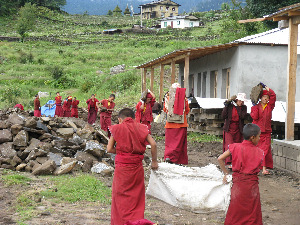
In addition to the 100 million mani retreats taking place over the next six months, the Lama Zopa Rinpoche Bodhichitta Fund is offering all the cost of food to all the nuns for this period as well as the cost of a very qualified geshe to stay during the retreat in order to give lam-rim teachings. This is very important for the nuns’ studies. The retreat lasts three months and about seventy nuns participate. Each nun doing the recitations receives a small offering and the nunnery also receives an offering. This is the main means of support for the nuns and the nunnery.
100 Million Mani Retreats Sponsored
- 2009: One retreat sponsored during Saka Dawa
- 2010: One retreat sponsored during Saka Dawa
- 2011: One retreat sponsored during Saka Dawa
- 2012: Two retreats sponsored over Saka Dawa
- 2013: Two retreats sponsored from December 2012-June 2013 beginning on Lama Tsongkhapa Day
UPDATE April 2013: Lama Zopa Rinpoche just received this message from the Tashi Chime Gatsal Nuns who are currently doing their 2nd 100 million mani retreat. More….
If you would like to contribute to to Rinpoche’s ongoing commitment to sponsor these 100 million mani retreats:
Lama Zopa Rinpoche’s Vast Vision for 100 Million Mani Retreats
This is the beginning of actualizing one of Rinpoche’s Vast Visions for FPMT which he explained in 2007: Sponsoring 100 Million Mani Retreats.
As Rinpoche explained:
“[I would like] for the organization to establish 100,000 recitations of 100 Million Om Mani Padme Hum. This can be retreats of 100 million recitations, so 100,000 different retreats in different parts of the world where it can happen regularly, each year.
There are two ways to count this. One way is once it is established for it to happen regularly each year. Or it can happen in different places, one time, and you count it like that. Maybe they are unable to do regularly but able to do one time or a few times.
So to establish this in different parts of the world such as Mongolia, Tibet, Nepal, Australia, China etc.
We should create a plan on how to lead the retreat of 100 million Om Mani Padme Hums: What practices to do, a plan on how to schedule the retreat, the whole structure. Once you have a structure then it is easy for people to lead the retreat.
Also you can make mani pills in the retreats.
During the retreat it is a great thing if you also take the 8 Mahayana Precepts during the retreat. You can have lunch and breakfast, but no dinner. People can take precepts for the whole time or every alternative week. So this depends on the different places. I think to combine these two is extremely great.
Then it would be very good if the retreats are sponsored by the organization. Sometimes it can also be sponsored privately, all the expenses. But the idea is to start as a project and then for the whole organization to sponsor. Or to sponsor the food or lodging. Like a center hosting, making the retreat free for everyone. The idea is for it to be sponsored so people do not have to pay. Also if an individual person is doing 100 Million Om Mani Padme Hums then still the organization can sponsor the person.
There is one story about Geshe Thubten Sopa, he led 100 Million Om Mani Padme Hum retreat in the monastery. I think he is regarded as an incarnate Lama, this is not known in Sera, but actually he’s an incarnate Lama. The monastery in Ladakh respect and regard him as an incarnate Lama.
What happened is during the retreat, the mani pills multiplied and that inspired so many people, to have faith and because of that there are now many monasteries in Ladhak that are doing 100 Million Om Mani Padme Hum Retreats. So this is a great thing.”
– Lama Zopa Rinpoche on his Vast Vision for FPMT, Kachoe Dechen Ling, Aptos, CA, March 2007
19
Lama Zopa Rinpoche Visits Sera Je Kitchen
October, 2012: Lama Zopa Rinpoche made a rare visit to the Sera Je Kitchen.
Rinpoche enjoyed the evening’s dinner that was was prepared for the 2,600 monks of Sera Je Monastery.
26
2012 Hightlights
October 2012: For the past fifteen years the Lama Tsongkhapa Teachers Fund has been offering a small monthly stipend to 136 of the most senior teachers, and secretaries, of Sera, Ganden, Drepung, Gyume, Gyuto, Tashi Lhunpo and Rato monasteries.
In addition, the fund sponsors the travel of the top students from Sera, Gaden and Drepung monasteries to the annual Gelug exam and provides the food and tea to the 600+ monks in attendance.
In 2012 USD$25,400 was offered for the exam and stipends.
How Can I Make a Donation?
To make a tax-deductible donation simply send your check in US dollars payable to FPMT Inc. and write “Lama Tsongkhapa Teachers Fund” on the memo line.
FPMT Inc.
1632 SE 11th Avenue
Portland, OR 97214-4702
USA
The Lama Tsongkhapa Teachers Fund is a project of FPMT Inc. and is administered by FPMT International Office located in Portland, Oregon, United States. All donations made to this fund are tax-deductible within the United States in accordance with IRS Code article 501(c)(3) to the extent allowed by law.
For more information please contact: Charitable Projects Coordinator.
- Tagged: lama tsongkhapa teachers fund
24
2011 Highlights
- US$17,427 was offered for the monthly stipends of the current abbots, past abbots and main teachers of the Lama Tsongkhapa tradition, including the Ganden Tripa.
- US$8,036 was offered for the annual Gelug examination that was attended by over 602 of the foremost scholars from Sera, Ganden, Drepung, Gyume, Gyuto, Tashi Lhunpo and Rato monasteries. In 2011, the exam was held at Drepung Monastery. This money covered the cost of travel for the monks traveling from Sera Je and Sera Me, as well the cost of offering food and tea to all the 602 monks attending the exam.
- Tagged: lama tsongkhapa teachers fund
1
Sera Je Food Fund Videos
June 2012: We are delighted to present you with new videos which help illustrate the many benefits of this project.
“A Brief Introduction to the Sera Je Food Fund” is a short introduction and overview of the project.
“The Making of Food” is 23-minute video providing a virtual tour of how the food is prepared for all 2,600 monks at Sera Je Monastery.
All Sera Je Food Fund videos can be found on our new video page on the Sera Je Food Fund web page.
1
Sera Je Food Fund’s New Videos!
June 2012: We are delighted to present you with new videos which help illustrate the many benefits of this project.
“A Brief Introduction to the Sera Je Food Fund” is a short introduction and overview of the project.
“The Making of Food” is 23-minute video providing a virtual tour of how the food is prepared for all 2,600 monks at Sera Je Monastery.
All Sera Je Food Fund videos can be found on our new video page on the Sera Je Food Fund web page.
Normal
0
false
false
false
EN-US
X-NONE
X-NONE
/* Style Definitions */
table.MsoNormalTable
{mso-style-name:”Table Normal”;
mso-tstyle-rowband-size:0;
mso-tstyle-colband-size:0;
mso-style-noshow:yes;
mso-style-priority:99;
mso-style-qformat:yes;
mso-style-parent:””;
mso-padding-alt:0in 5.4pt 0in 5.4pt;
mso-para-margin-top:0in;
mso-para-margin-right:0in;
mso-para-margin-bottom:10.0pt;
mso-para-margin-left:0in;
line-height:115%;
mso-pagination:widow-orphan;
font-size:11.0pt;
font-family:”Calibri”,”sans-serif”;
mso-ascii-font-family:Calibri;
mso-ascii-theme-font:minor-latin;
mso-fareast-font-family:”Times New Roman”;
mso-fareast-theme-font:minor-fareast;
mso-hansi-font-family:Calibri;
mso-hansi-theme-font:minor-latin;}
We are delighted to present you with new videos which help illustrate the many benefits of this project.
“A Brief Introduction to the Sera Je Food Fund” is a short introduction and overview of the project.
“The Making of Food” is 23-minute video providing a virtual tour of how the food is prepared for all 2,600 monks at Sera Je Monastery.
All Sera Je Food Fund videos can be found on our new video page on the Sera Je Food Fund web page. [CR1]
[CR1]Link to video page
1
Six Months of Food Offered
June 2012: FPMT was able to send US$115,000 to Sera Je Monastery. This contribution covers the next six months’ worth of meals for all 2,600 monks currently studying at Sera Je.
Thank you to all the kind benefactors who support this amazing project and please rejoice in this incredible offering that we are able to make to the Sangha, our future center geshes and to His Holiness the Dalai Lama.
“If you offer with the recognition that they are the guru’s pores,” Lama Zopa Rinpoche said in 2011, “then that is an unbelievable way to collect merit. When you offer to many Sangha who have the same guru, then you are making offerings to that many pores of the guru. This is the easiest way to collect skies of merit by offering. By offering even just one candy or flowers or even one grain of rice to a statue of Buddha or even a visualized Buddha, you collect skies of merit. It is much more powerful than offering to the Three Jewels (Buddha, Dharma, Sangha) as well as all the statues, stupas and scriptures existing in all directions, so there is no question if really offering to the same guru’s disciple. These benefits should be understood so that when you make offerings to the guru’s pores that you think correctly. This is the best business.”
1
By Geshe Thubten Jinpa
Received May 2012: The sun is at its brightest at 9 a.m., but a soft breeze blows making the morning chilly. Hundreds of monks in their maroon robes begin to flow in, clutching a square cushion in their right hands, like someone going to the office would carry a briefcase, and a plate in their left hands. Soon the debate courtyard is full with thousands of them and before long the courtyard turns into a huge garden of red roses.
After an hour-and-a-half long prayer session, everyone scatters all over the courtyard, each looking for a debate partner. In less than a minute the whole yard is covered with monks debating in pairs.
Thousands of hands clapping together with loud voices of Dharma discussion makes it sound like the middle of India’s busiest train station. Everyone seems so enthusiastic and absorbed in debate. Amazed and transfixed by the atmosphere around me, I hardly notice that time is running. It is 11:30 a.m. when the disciplinary master signals the conclusion of the morning session.
The senior monks gradually move towards the dining hall but so many other junior ones are still fully engaged in the high fever of debate, looking so determined to prove their side of the argument.
By the time I find my seat in the dining room, many senior monks have taken theirs in the front rows as more monks make their way into the dining room. Soon the hall is filled with thousands of monks and a deep voice far in front begins to roar. I realize it is the prayer from Lama Tsongkhapa’s “Songs of Experience,” with its repeated verse: “I, the practitioner has practiced in this way. You the seeker of liberation, practice in the same way.”
As I listen to this prayer, my eyes roll over the many monks sitting around me. All of them look like they are in their thirties and forties, mostly quite skinny, the maroon of their robes a little faded, heads fully shaved, yet looking glorious sitting so calmly in concentration, perhaps contemplating the words of the prayer. Then hundreds of junior monks rush in with basins, buckets and kettles of food. It is an international marathon with Indians, Europeans, Americans, Chinese and Koreans among the procession serving the meal.
I am totally thrilled by this spectacular atmosphere, but as the serving of food begins my heart suddenly fills with a strange mixture of joy and sentiment. I am thrown back down memory lane to when Kyabje Lama Zopa Rinpoche was emphasizing so much about the Sera Je Food Fund project, when he explained to every benefactor about its importance, and the time he put his palms together to appeal for support for the project. I recall Rinpoche working so hard to start this project and all the time and effort he took to make it run smoothly.
A part of my mind is rejoicing, “How wonderful the job Rinpoche has done! How kind he is. What an abundance of merit he let so many people create!” I cannot recall every thought that arose at that moment but it is all so emotional, hearing the voice reciting Lama Tsongkhapa’s inspirational prayer above these thoughts as my heart is moved more than ever with rejoicing and admiration. Then my heart explodes with extraordinary faith and tears begin to roll down my cheeks, silently slipping under my spectacles. I come to realize only when a drop falls into my rice bowl. By then my voice has turned soft and I find myself crying uncontrollably. Perhaps people around me start to notice.
By now, rice, dhal and a piece of fruit is served to each monk in the hall and food offering prayers begin. I sense unconditional appreciation and profound dedication in every monk throughout the offering prayer. Everyone begins to eat. For me, it is the most delicious dhal and rice I ever tasted. Silence is unbroken while thousands of monks empty their bowls, but I cannot finish my share as the feeling of admiration for my guru’s extraordinary deed makes me constantly emotional.
Soon with dedication prayers completed, all the monks leave their seats making way for the juniors to clean the place. I have no choice but to leave with the remaining food left in my bowl. As I walk out I notice a group of old monks, mostly in their seventies and eighties, some crippled with stick in right hand and a bowl in the left.
I go up to one of them whom I know and ask why he needs to come all the way when he can send one of his young disciples to fetch food for him.
He gives me a toothless smile and answers: Eating in the Sangha assembly means not only sharing the food but sharing our merit by making it greater, making our merit stronger, and dedicating for the happiness of all sentient beings. It is also to rejoice in the great deeds of Kyabje Lama Zopa Rinpoche and all the benefactors of the Food Fund. He puts his palms together every time the name of my guru was mentioned. He keeps saying that coming to the Sangha assembly is never troublesome to him when he thinks of what wonderful karma has been created by those who have made this food offering possible.
I feel so much joy to see for myself the immense benefits that Kyabje Lama Zopa Rinpoche and his disciples worldwide have brought to the entire Sangha assembly of Sera Je Monastery through the Food Fund Project!
Written by Geshe Thubten Jinpa, November 28, 2011. Edited by Ven. Tenzin Tsultrim April 4, 2012. Gently edited for inclusion here.
1
Dried Food for Monks over Losar
February 2012: Dried food was distributed to about 2,550 of our Sera Je monks! No, not to celebrate Valentine’s Day but because our main kitchen will be closed during the coming two weeks Losar (Tibetan New Year) holidays.
Each monk received 2.5 kg of rice, 4 kg of flour and 0.5 liter of cooking oil. In total, we have distributed 6375 kg of rice, 10,200 kg of flour and 1275 liters of cooking oil!
A BIG Thank You to all the Sera Je Food Fund sponsors!
1
Sera Je Food Fund’s Amazing New Bread-Making Machine
August 2011: Cherok Lama generously sponsored a new bread-making machine for the Sera Je Food Fund kitchen. This was offered on the occasion of his Rik-Chung ceremony in August of last year.
This new machine has reduced the need for kitchen helpers (who are all monks studying in the monastery) by 50%. This means that these monks will have more time for their studies and practices!
Please enjoy this short video of the bread-making machine in action.
On the first day it managed to produce more than 800 loaves of bread for the day’s lunch in two hours, and again in the afternoon, 1,200 loads of bread for next day’s breakfast! This is a great improvement for the Sera Je Food Fund kitchen.
We also thank Cherok Lama for offering US$13,000 for a new refrigerator for the Sera Je Food Fund kitchen.
2
Ösel in the Sera Je Food Fund Kitchen
January 2012: Tenzin Ösel Hita visited Sera Je Monastery and made a point to check out the Sera Je Food Fund kitchen.
- Home
- News/Media
- Study & Practice
- About FPMT Education Services
- Latest News
- Programs
- New to Buddhism?
- Buddhist Mind Science: Activating Your Potential
- Heart Advice for Death and Dying
- Discovering Buddhism
- Living in the Path
- Exploring Buddhism
- FPMT Basic Program
- FPMT Masters Program
- FPMT In-Depth Meditation Training
- Maitripa College
- Lotsawa Rinchen Zangpo Translator Program
- Universal Education for Compassion & Wisdom
- Online Learning Center
- Prayers & Practice Materials
- Overview of Prayers & Practices
- Full Catalogue of Prayers & Practice Materials
- Explore Popular Topics
- Benefiting Animals
- Chenrezig Resources
- Death & Dying Resources
- Lama Chopa (Guru Puja)
- Lama Zopa Rinpoche: Compendium of Precious Instructions
- Lama Zopa Rinpoche: Life Practice Advice
- Lama Zopa Rinpoche Practice Series
- Lamrim Resources
- Mantras
- Prayer Book Updates
- Purification Practices
- Sutras
- Thought Transformation (Lojong)
- Audio Materials
- Dharma Dates – Tibetan Calendar
- Translation Services
- Publishing Services
- Teachings and Advice
- Find Teachings and Advice
- Lama Zopa Rinpoche Advice Page
- Lama Zopa Rinpoche: Compendium of Precious Instructions
- Lama Zopa Rinpoche Video Teachings
- ༧སྐྱབས་རྗེ་བཟོད་པ་རིན་པོ་ཆེ་མཆོག་ནས་སྩལ་བའི་བཀའ་སློབ་བརྙན་འཕྲིན།
- Podcasts
- Lama Yeshe Wisdom Archive
- Buddhism FAQ
- Dharma for Young People
- Resources on Holy Objects
- Ways to Offer Support
- Centers
- Affiliates Area
- Teachers
- Projects
- Charitable Projects
- Make a Donation
- Applying for Grants
- News about Projects
- Other Projects within FPMT
- Support International Office
- Projects Photo Galleries
- Give Where Most Needed
- FPMT
- Shop
Translate*
*powered by Google TranslateTranslation of pages on fpmt.org is performed by Google Translate, a third party service which FPMT has no control over. The service provides automated computer translations that are only an approximation of the websites' original content. The translations should not be considered exact and only used as a rough guide.If you have fear of some pain or suffering, you should examine whether there is anything you can do about it. If you can, there is no need to worry about it; if you cannot do anything, then there is also no need to worry.
